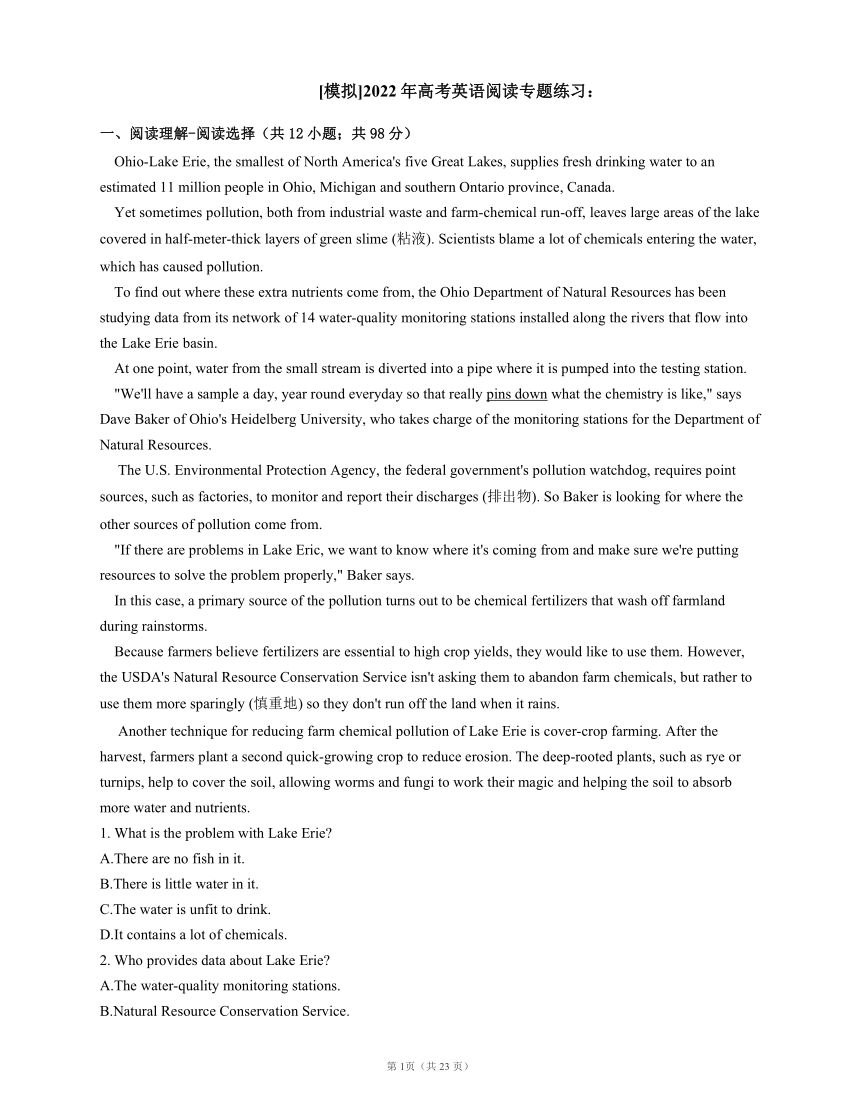
[模拟]2022年高考英语阅读专题练习: 一、阅读理解-阅读选择(共12小题;共98分) Ohio-Lake Erie, the smallest of North America's five Great Lakes, supplies fresh drinking water to an estimated 11 million people in Ohio, Michigan and southern Ontario province, Canada. Yet sometimes pollution, both from industrial waste and farm-chemical run-off, leaves large areas of the lake covered in half-meter-thick layers of green slime (粘液). Scientists blame a lot of chemicals entering the water, which has caused pollution. To find out where these extra nutrients come from, the Ohio Department of Natural Resources has been studying data from its network of 14 water-quality monitoring stations installed along the rivers that flow into the Lake Erie basin. At one point, water from the small stream is diverted into a pipe where it is pumped into the testing station. "We'll have a sample a day, year round everyday so that really pins down what the chemistry is like," says Dave Baker of Ohio's Heidelberg University, who takes charge of the monitoring stations for the Department of Natural Resources. The U.S. Environmental Protection Agency, the federal government's pollution watchdog, requires point sources, such as factories, to monitor and report their discharges (排出物). So Baker is looking for where the other sources of pollution come from. "If there are problems in Lake Eric, we want to know where it's coming from and make sure we're putting resources to solve the problem properly," Baker says. In this case, a primary source of the pollution turns out to be chemical fertilizers that wash off farmland during rainstorms. Because farmers believe fertilizers are essential to high crop yields, they would like to use them. However, the USDA's Natural Resource Conservation Service isn't asking them to abandon farm chemicals, but rather to use them more sparingly (慎重地) so they don't run off the land when it rains. Another technique for reducing farm chemical pollution of Lake Erie is cover-crop farming. After the harvest, farmers plant a second quick-growing crop to reduce erosion. The deep-rooted plants, such as rye or turnips, help to cover the soil, allowing worms and fungi to work their magic and helping the soil to absorb more water and nutrients. 1. What is the problem with Lake Erie A.There are no fish in it. B.There is little water in it. C.The water is unfit to drink. D.It contains a lot of chemicals. 2. Who provides data about Lake Erie A.The water-quality monitoring stations. B.Natural Resource Conservation Service. C.The Ohio Department of Natural Resources. D.The U.S. Environmental Protection Agency. 3. The underlined phrase "pins down" in Paragraph 5 probably means "_____". A.looks through B.explains exactly C.keeps a record of D.shows clearly 4. What causes the pollution in Lake Erie A.Animal waste from nearby farms. B.Waste water from a nearby factory. C.Chemical fertilizers from the fields. D.Pesticide farmers used to kill locusts. 5. Quick-growin ... ...
~~ 您好,已阅读到文档的结尾了 ~~

